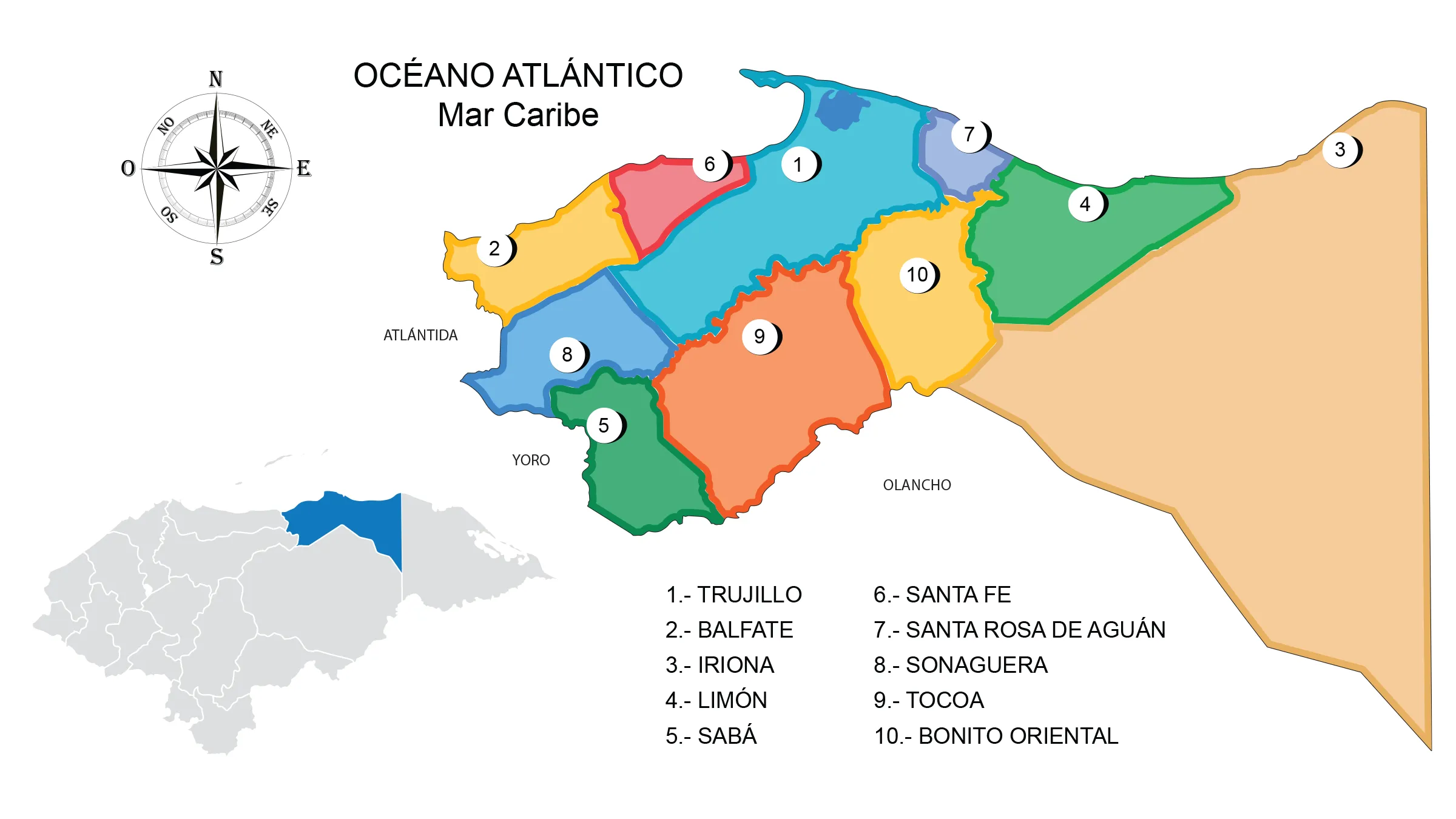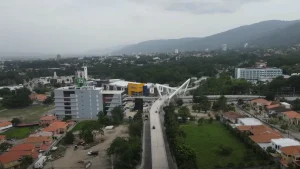Department of Colon

Colón is one of the 18 departments of the Republic of Honduras.
Ver Map of Departament of Colon
Origin of its name: It is named after the Genoese admiral Christopher Columbus, who arrived at the site he called Punta Caxinas during his fourth and final voyage in July 1502.
History
When the first political territorial division was made in 1825, Colón was part of Yoro until 1881 when a new department was formed with a part of Yoro and the Mosquitia. In order to organize it conveniently, the higher authority appointed a commission to thoroughly explore and study the Mosquitia. This commission stated that in order to be governed, it should be divided into three districts:
- From the right bank of the Aguán River to the left bank of the Negro or Tinto River, with its headquarters in Iriona.
- From the right bank of the Negro River to the left bank of the Butuco River, with its headquarters in La Criba.
- From the right bank of the Butuco River to the Cape of Gracias a Dios, with its headquarters in Caratasca. Each district would have a governor whose functions would be the same as those of a mayor.
Founded as a department on December 19, 1891, during the administration of President Ponciano Leiva, its departmental capital is the City of Trujillo.
It is located in the northern sector of the country and has a long coastline on the Caribbean Sea to the north. Its territory is crossed by several rivers, including the Seco and El Paulaya.
Colón is a department located in the northern and eastern part of Honduras. Its departmental capital is Trujillo. It was created on December 19, 1881, and divided in 1859. Its population is 246,708.
Its economy is mainly based on agriculture, such as coffee, cotton, and bananas, and it has ten municipalities.
Municipalities of Colón
See List of Municipalities in Honduras
- Trujillo Cabecera departamental 0201
- Balfate 0202
- Iriona 0203
- Limón 0204
- Sabá 0205
- Santa Fe0206
- Santa Rosa de Aguán 0207
- Sonaguera0208
- Tocoa 0209
- Bonito Oriental 0210
History of Colón
The pre-Hispanic inhabitants of the current department of Colón can be described as organized groups in what ethno-historians call «geopolitical units of indigenous origin,» such as the Papayeca, Chapagua, and Peicacura units in the center-east of the territory of Honduras at the time of contact.
In his fourth and final voyage, Christopher Columbus arrived at Punta Caxinas, very close to the city of Trujillo, which was founded by Juan de Medina on May 18, 1525. The first civil and ecclesiastical authorities were established there in 1535. Through the port of Trujillo, Honduras protected the eastern coastline of the Caribbean Sea and facilitated trade between Spain and Comayagua.
The constituent assembly of Honduras, held in Comayagua on June 28, 1825, decreed the first territorial division of the state of Honduras, stating that the department of Yoro would have Trujillo as its parish. The foundation of the current department of Colón took place on December 19, 1881, during the administration of Marco Aurelio Soto. It became the largest department at that time, covering Atlántida, Yoro, and the region of La Mosquitia. It was later reduced with the creation of the departments of Atlántida in 1902 and Gracias a Dios in 1957.
Geography of Colón
Location: Situated in the easternmost part of the country.
Boundaries
- North: Caribbean Sea;
- South: Department of Olancho;
- East: Department of Gracias a Dios;
- West: Departments of Yoro and Atlántida.
Rivers: Aguán, Bejucal or Balfate, Chapagua, Paulaya, Sico, Tinto or Negro, Tocoa
Protected Areas: National Park Capiro and Calentura; Wildlife Refuge Guaymoreto Lagoon; and Biological Reserve Río Tinto.
Lakes: Guaimoreto
Mountain Ranges: Nombre de Dios, La Esperanza.
Mountains: Pico Blanco, Capiro and Calentura, Botaderos, Río Tinto, Punta Piedra, and Río Plátano.
Economy of Colón
Production: Cultivation of banana, plantain, cocoa, orange, African palm, pineapple, corn, rice, yuca, and malanga; raising of cattle, horses, and pigs.
Commerce: Tocoa stands out for its commerce, and Puerto Castilla serves as a port center.
Mines: Gold and antimony deposits.
Fauna and Flora of Colón
Mammals: Shrew, squirrel, coati, anteater, skunk, raccoon, deer, agouti, howler monkey, spider monkey, tapir, peccary, coyote, fox, wildcat, puma, margay, ocelot, and jaguar.
Birds: Woodpecker, ocotera dove, roadrunner or alma de perro, grackle, seagull, pelican, turtledove, parakeet, trogon or guardabarranco, macaw, thrush, heron, hawk, bearded vulture, owls, and osprey.
Marine Species: Crab, lobster, dolphin, whale shark, shrimp, crab, manta ray, and a variety of fish found in coral reefs.
Flora: Broadleaf forests along the coastal area and the Sico River zone; coniferous forests on the mountain slopes.
Tourism in Colón
- City of Trujillo
- Santa Bárbara Castle
- The most beautiful beaches of Honduras in the Atlantic.



